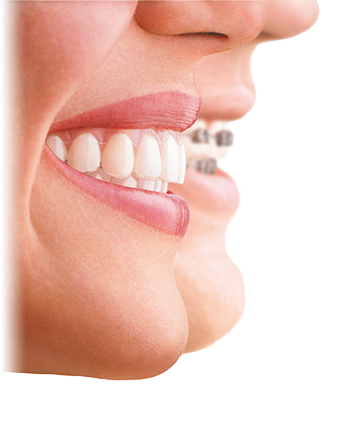 Few of us relish the though of having a mouth full of metal and wires, yet all of us yearn for beautiful straight teeth, so wearing a brace is often the price we have to pay. Braces can be embarrassing, especially for the millions of teenagers who have to wear them in the most difficult and emotionally challenging times of their lives. For older patients, wearing a brace can have the stigma attached that they are too old for braces.
Few of us relish the though of having a mouth full of metal and wires, yet all of us yearn for beautiful straight teeth, so wearing a brace is often the price we have to pay. Braces can be embarrassing, especially for the millions of teenagers who have to wear them in the most difficult and emotionally challenging times of their lives. For older patients, wearing a brace can have the stigma attached that they are too old for braces.
Now there is an alternative to uncomfortable and ugly metal braces. Invisalign is a system of invisible braces that can help to straighten you teeth without the need to construct a scrap yard in your mouth. Introduced in 1999 by Align technologies, Invisalign is a series of plastic retainers that fit over the patient’s teeth gradually forcing them into position. Each set of retainers needs to be worn for two to three weeks before a new set is used. Usually twenty or so sets of retainers are needed to complete a full treatment, depending on the patient.
The retainers are made from one-millimeter thick clear plastic and are almost impossible to see unless standing extremely close to the patient’s mouth. The braces are also removable so can be taken out at meal times. This means that unlike other braces certain foods are not of limit.
While invisible braces have existed before they have never had the degree of accuracy of Invisalign. Due to the advancements of technology, and introduction of CAD/CAM (computer aided design/computer aided manufacture), Invisalign braces can be made to the exact specifications of a 3D projection. A Central Leeds dentist will be able to make this 3D projection from one mold and an x-ray, then a computer guided machine can manufacture the retainers, in a fraction of the time of previous invisible braces, to an unbelievable standard of accuracy.
Although Invisalign braces may not be suitable for all patients, and it has to be said conventional metal braces have also come a long way, an Invisalign brace can straighten your teeth without knocking your confidence. Ask a Central Leeds dentist if Invisalign can help you straighten your teeth. Call 0113 245 4868 to make an appointment for free consultation.





 Everybody wants to have straight teeth, but for those not born with naturally straight nashers, the only real option is to have them straightened. In the past this has meant wearing uncomfortable and unseemly metal braces, which can be the source of great embarrassment, especially for teenagers. More recently, we have seen the advent of invisible plastic braces which, while discreet, often take a very long time to be effective.
Everybody wants to have straight teeth, but for those not born with naturally straight nashers, the only real option is to have them straightened. In the past this has meant wearing uncomfortable and unseemly metal braces, which can be the source of great embarrassment, especially for teenagers. More recently, we have seen the advent of invisible plastic braces which, while discreet, often take a very long time to be effective. At one time or another, whether we are aware of it or not, we all will have suffered from bad breath. Bad breath, or halitosis as it is otherwise known, can strike anyone at any time unless you take preventative measures. Mouthwashes and chewing gum can mask the smell of bad breath but they don’t get to the causes so it is likely to return. Because it is so difficult to tell if your breath smells (we’ve all done the hand cupping move at some point) only a strong regime of preventative measures can alleviate the anxiety that you have bad breath.
At one time or another, whether we are aware of it or not, we all will have suffered from bad breath. Bad breath, or halitosis as it is otherwise known, can strike anyone at any time unless you take preventative measures. Mouthwashes and chewing gum can mask the smell of bad breath but they don’t get to the causes so it is likely to return. Because it is so difficult to tell if your breath smells (we’ve all done the hand cupping move at some point) only a strong regime of preventative measures can alleviate the anxiety that you have bad breath. A pair of well-constructed and accurately fitting dentures should be secured in place by suction and fit alone but occasionally an adhesive is necessary to secure them. Other people just feel more confident knowing their dentures are secured, but adhesive gels and strips can be messy and make the eating of certain foods very difficult. More and more patients are opting for dentures that are secured with dental implants for a more permanent hold that can provide extra confidence when wearing dentures.
A pair of well-constructed and accurately fitting dentures should be secured in place by suction and fit alone but occasionally an adhesive is necessary to secure them. Other people just feel more confident knowing their dentures are secured, but adhesive gels and strips can be messy and make the eating of certain foods very difficult. More and more patients are opting for dentures that are secured with dental implants for a more permanent hold that can provide extra confidence when wearing dentures. A missing tooth that has been caused by decay or has been knocked out in an accident can not only be cause of embarrassment but can also cause further dental complications if not replaced. Existing teeth tend to lean into empty spaces in the toothline causing sagging of the facial tissue and complications that can alter bite and profile. A missing tooth can also allow bacteria to develop on food particles that become lodged in the recess. This develops into plaque, a filmy substance that covers teeth and causes tooth decay. It is therefore very important that missing teeth are replaced as soon as possible.
A missing tooth that has been caused by decay or has been knocked out in an accident can not only be cause of embarrassment but can also cause further dental complications if not replaced. Existing teeth tend to lean into empty spaces in the toothline causing sagging of the facial tissue and complications that can alter bite and profile. A missing tooth can also allow bacteria to develop on food particles that become lodged in the recess. This develops into plaque, a filmy substance that covers teeth and causes tooth decay. It is therefore very important that missing teeth are replaced as soon as possible. For patients who have suffered a cracked, broken or damaged tooth, a
For patients who have suffered a cracked, broken or damaged tooth, a  When a tooth is missing because it has decayed or has been knocked out in an accident, it leaves a space in the tooth line. This space can be detrimental to remaining teeth and oral hygiene as a whole. Existing teeth tend to lean into the space created by the missing tooth. It can also cause sagging of the facial tissue, specifically if there is more than one tooth missing.
When a tooth is missing because it has decayed or has been knocked out in an accident, it leaves a space in the tooth line. This space can be detrimental to remaining teeth and oral hygiene as a whole. Existing teeth tend to lean into the space created by the missing tooth. It can also cause sagging of the facial tissue, specifically if there is more than one tooth missing. There have been astonishing leaps forward in dental technology in the last 30 years. The dentist surgeries most of us visited as children are no longer and today dentist surgeries today resemble health spas more than hospitals. The technology that is behind these advances is truly cutting edge. One of the very latest is CEREC technology. This stands for CEramic REConstruction and is a revolutionary new system that allows dentists to design, manufacture and fit a
There have been astonishing leaps forward in dental technology in the last 30 years. The dentist surgeries most of us visited as children are no longer and today dentist surgeries today resemble health spas more than hospitals. The technology that is behind these advances is truly cutting edge. One of the very latest is CEREC technology. This stands for CEramic REConstruction and is a revolutionary new system that allows dentists to design, manufacture and fit a 

